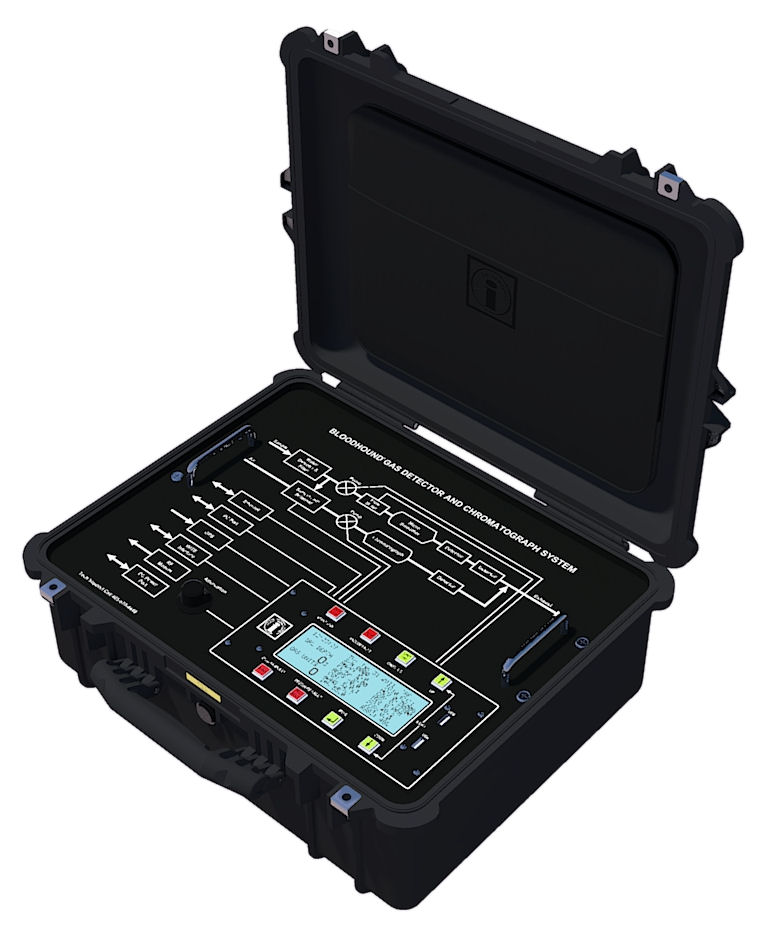This article highlights some of the key features and benefits of the Bloodhound Logging System.
PREREQUSITES: There are no prerequisites for this article.
GENERAL INFORMATION:
The Bloodhound logging system is shown below. It is a self-contained logging system that comes in a comparably small package which can be easily transported. It is designed to be setup on a basic level very quickly, but also has a great deal of custom capability through the highly configurable logic controller that drives the system.

1) DETECTION: The Bloodhound uses an infrared hydrocarbon sensor array that gives a complete package as far as the overall analysis of gas is concerned. Specific features and benefits of this Hotwire Replacement Module (HRM) array include:
a) 0 to 100% Auto Ranging.
b) Total Gas with Chromatograph to Model C1 through C4 (including isobutane and normal butane).
c) Accurate and Sensitive with Auto Ranging d) Low End plus or minus .0001% equals one unit (on 10,000 unit full range)
e) High End plus or minus 1% full scale
f) Reliability (due to the fact that there is no filament, flame or pellistor to fail):
i) No saturation
ii) No in-field calibration required (set and stable for 18 months)
iii) No drift from filament degradation
iv) No drift from carbonization
g) CO2 detection – included in the Bloodhound
h) O2 detection – included in the Bloodhound
i) H2S detection – included (but turned off by default) in the Bloodhound
2) DATA: The Bloodhound, being a digital device, relies on numeric data to collect, store, and present the results of its analysis. As one might guess, the value of this data is very high, and it is protected in a number of ways on the Bloodhound:
a) The Bloodhound is capable of at minimum doubly-redundant data on the Bloodhound itself. When connected on-line to the Internet, it automatically becomes triply- redundant. When you connect a local worksite computer to the Bloodhound, it is then quadruply-redundant.
b) The Bloodhound collects data in a near-real-time fashion with at minimum a six- second capture cycle. With the connectivity capability of the Bloodhound through the Internet, this data can be viewed on the rig-site or anywhere in the world via website, or remote-monitoring tools.
c) WITS: The Bloodhound is bi-directionally WITS compatible, meaning it can provide third-party gas to any WITS system using ANSI-standard WITS channels, and it can receive any ANSI-standard WITS data provided to it, such as bit depth, hole depth, and so on.
3) AUTOMATION: With the benefit of Internet-ready remote connectivity to the Bloodhound, logging automation options abound, including:
1) Remote systems diagnostics – When you call your home-base, or the Bloodhound Support staff, they can remotely connect to your Bloodhound and perform diagnostics, system checks, etc.
2) The Bloodhound has a built-in alarm system with an audible and visible alarm.
3) The Bloodhound can provide data to an Internet monitoring system which can e-mail or text alerts to the on-site staff, or headquarters.
4) On-Site Gas Chart Software can be setup to audibly announce conditions such as high gas, low gas, pressure faults, etc.
5) On-Site Gas Chart Software can generate a real-time mud log (just add lithology).
6) The Bloodhound has a sample flow rate meter built-in, and uses this meter to regulate the internal sample pump motor, and maintain a constant sample flor rate.
4) COMMUNICATION: The Bloodhound has a number of different mechanisms and options for data communication, including:
1) Hardwire connection to on-site computer, or to a network router.
2) Wireless GPRS connection to the Internet (eliminates need for satellite).
3) The aforementioned alarms that can be setup via phone text message or e-mail worldwide.
5) POWER: The Bloodhound’s power system is designed to be rugged and to handle long-span operating times without trouble:
a) Low operating current design (DC low-voltage extends the life and eliminates shock danger).
b) Functional from a 12v automobile electrical system.
c) Up to 120 minutes of on-board battery backup with monitor.
6) MONITORING: There are a number of mechanisms that make remote monitoring of the Bloodhound easy. Some of the features and benefits include:
a) Remote diagnostics can be done on sample flow, vacuum, pressure, total hydrocarbon, and many many other functions.
b) Multiple function automatic alarms can be set based on custom high and low parameters in both the local Gas Chart Software and the on-line monitoring system, with notifications to cell phones, text phones, e-mail addresses, and plain-old audible alarms.
And that is an overall summary of the Bloodhound’s features and benefits!